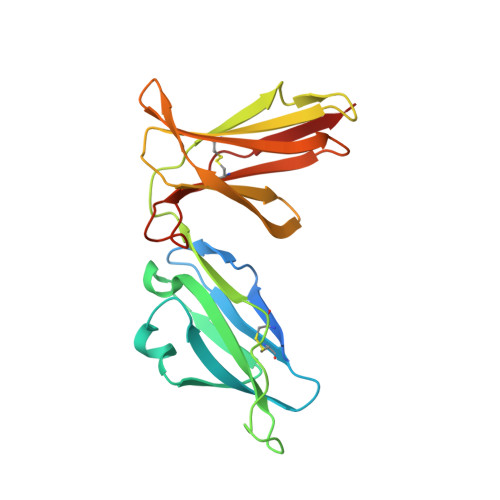The structure of the atypical killer cell immunoglobulin-like receptor, KIR2DL4.
Moradi, S., Berry, R., Pymm, P., Hitchen, C., Beckham, S.A., Wilce, M.C., Walpole, N.G., Clements, C.S., Reid, H.H., Perugini, M.A., Brooks, A.G., Rossjohn, J., Vivian, J.P.(2015) J Biol Chem 290: 10460-10471
- PubMed: 25759384
- DOI: https://doi.org/10.1074/jbc.M114.612291
- Primary Citation of Related Structures:
3WYR - PubMed Abstract:
The engagement of natural killer cell immunoglobulin-like receptors (KIRs) with their target ligands, human leukocyte antigen (HLA) molecules, is a critical component of innate immunity. Structurally, KIRs typically have either two (D1-D2) or three (D0-D1-D2) extracellular immunoglobulin domains, with the D1 and D2 domain recognizing the α1 and α2 helices of HLA, respectively, whereas the D0 domain of the KIR3DLs binds a loop region flanking the α1 helix of the HLA molecule. KIR2DL4 is distinct from other KIRs (except KIR2DL5) in that it does not contain a D1 domain and instead has a D0-D2 arrangement. Functionally, KIR2DL4 is also atypical in that, unlike all other KIRs, KIR2DL4 has both activating and inhibitory signaling domains. Here, we determined the 2.8 Å crystal structure of the extracellular domains of KIR2DL4. Structurally, KIR2DL4 is reminiscent of other KIR2DL receptors, with the D0 and D2 adopting the C2-type immunoglobulin fold arranged with an acute elbow angle. However, KIR2DL4 self-associated via the D0 domain in a concentration-dependent manner and was observed as a tetramer in the crystal lattice by size exclusion chromatography, dynamic light scattering, analytical ultracentrifugation, and small angle x-ray scattering experiments. The assignment of residues in the D0 domain to forming the KIR2DL4 tetramer precludes an interaction with HLA akin to that observed for KIR3DL1. Accordingly, no interaction was observed to HLA by direct binding studies. Our data suggest that the unique functional properties of KIR2DL4 may be mediated by self-association of the receptor.
Organizational Affiliation:
From the Department of Biochemistry and Molecular Biology, School of Biomedical Sciences, and.















